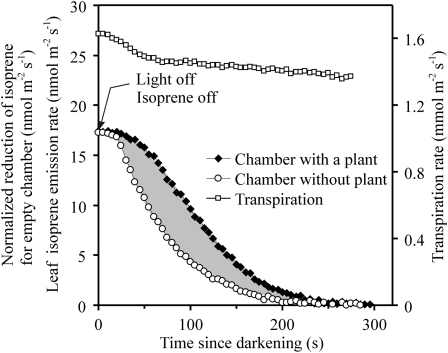Figure 1.
Sample recordings of postillumination isoprene emission rate (chamber with hybrid aspen, clone 200) and normalized system transient response (chamber without the plant). The transient response of the system was assessed using an artificial isoprene source. First, a steady-state isoprene flow was established, then isoprene flow was turned off and the system transient response was recorded. This system-specific response curve (the shape of which is independent of isoprene concentration of the isoprene source) was scaled to given leaf isoprene emission rates at steady-state conditions before switching off the light (i.e. the empty-chamber response was normalized with respect to leaf isoprene emission rate at 0 s). DMADP pool size was calculated as the area between the curves with and without the plant, as shown by the shaded area. Transpiration rate measurements together with leaf energy balance calculations demonstrated that there was a small decrease in leaf temperature of approximately 1.4°C (from 29.1°C to 27.7°C) corresponding to the initial drop of leaf transpiration rate (from 1.6 to 1.45 mmol m−2 s−1) and a further approximately 10% reduction in stomatal conductance (from 120 to 110 mmol m−2 s−1) after switching off the light.

